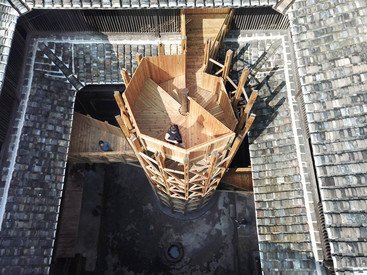A Rounded Approach to Revitalisation
The project’s impact lies in showing the potential for the different ways of revitalising a space.
More than a thousand years ago, people in parts of Fujian Province lived collectively in multi-level homes built in circular structures called Tulou, where life revolved around farming and the inhabitants shared a convivial central courtyard. Each family lived in a vertical slice of the structure and the outer wall bound them together as a community while also serving as a collective defence.
While some Tulou have been abandoned as occupants moved to the cities, others are still inhabited and have evolved in different ways. The courtyards, for instance, have varied uses – some are used as a school, a temple or a marketplace, with inhabitants of different Tulou visiting each other’s courtyards to make use of the facilities.
For Mr John Lin, Associate Professorof the Department of Architecture, the Tulou offered an intriguing opportunity to reinvigorate the structures with a view to encouraging renovation, raising public awareness and at the same time increasing the likelihood of preservation. “A lot of the unique culture of places is being slowly eradicated,” he explained. By reinvigorating the Tulou, he hoped to help its inhabitants become more self-reliant and to spread ideas about how to use Tulou in ways more suited to modern life.
The project also provided an opportunity to allow students a hands-on experience in designing and constructing new structures while at the same time respecting and preserving the ancient original buildings. At one Tulou, more than 40 Hong Kong students took part in the building of a new wooden tower with a staircase inside. Located in the middle of the courtyard, it provides shared access to the different levels of the Tulou. The team also built a ‘Plug-in’ – a wooden funnel-like structure that provides a stepped entrance to an inner room of the Tulou on the ground floor, which now houses a library. The sheltered steps of the Plug-in have become a favourite place for young children to gather and play.
During the project, students learned first-hand about traditional timber craftsmanship and the practical realities of rural to urban transformation and its impact on communities.
Just as adding the tower provides a new way of connecting the existing floors, the project’s impact lies in showing the potential for the different ways of revitalising a space. The project also provided the villagers with a way of preserving their treasured memories and sharing and celebrating them in a new museum. That has led to more visitors and tourism, bringing more business to the locals and in turn, to more appreciation of the unique Tulou structures.
“We’re really celebrating how adaptive architecture is, and shining a light on the fact that these constructions have been evolving throughout their existence, and proving that this can still be a way of life if we adapt them,” said Mr Lin.
Mr Chun-han John Lin of the Department of Architecture received the Faculty Knowledge Exchange Award 2020 of the Faculty of Architecture for the project ‘Rethinking the Collective: Renovation Strategies for Strengthening the Tulou Community’.






